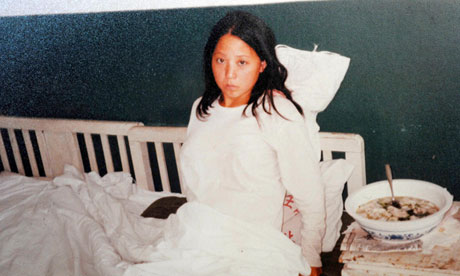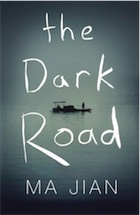For more than 30 years, China has upheld a strict one-child policy. And despite the country's growing prosperity, novelist Ma Jian discovered that ruthless squads still brutally enforce the law with vast fines – and compulsory sterilisations and abortions

Jin Yani, who was forced to abort her baby nine months into her pregnancy. Photograph: Sinopix/Rex Features
In China, procreation and childbirth are, like every facet of human life, deeply political. Since the Communist party came to power in 1949, it has viewed the country's population as a faceless number that it can increase or decrease as it chooses, not a society of individuals with unique desires and inviolable rights. At first, Mao Zedong encouraged large families and outlawed abortion and the use of contraception, urging women to produce offspring who would boost the workforce and the ranks of the People's Liberation Army. My mother dutifully gave birth to five children. Our neighbour, Mrs Wang, produced 11, and was declared a "Heroine Mother" by the local authorities and given a large red rosette to pin to her lapel.
 Mao's reckless strategy caused China's population to double from about 500 million in 1949 to almost a billion three decades later. By the time Deng Xiaoping took over the reins in 1978 after the calamitous cultural revolution, not only was Mao dead, but so was all faith in communist ideology. Deng knew that for the party to regain legitimacy, it would have to achieve economic growth, and a small group of technocrats, headed by rocket scientist Song Jian, persuaded him that for China to meet its economic targets for the year 2000, its population would have to be restricted to 1.2 billion. The one-child policy they proposed was swiftly introduced: couples in China could have only one child, or in the countryside two if the first child was a girl. The production of children became as subject to state targets and quotas as the production of grain and steel.
Mao's reckless strategy caused China's population to double from about 500 million in 1949 to almost a billion three decades later. By the time Deng Xiaoping took over the reins in 1978 after the calamitous cultural revolution, not only was Mao dead, but so was all faith in communist ideology. Deng knew that for the party to regain legitimacy, it would have to achieve economic growth, and a small group of technocrats, headed by rocket scientist Song Jian, persuaded him that for China to meet its economic targets for the year 2000, its population would have to be restricted to 1.2 billion. The one-child policy they proposed was swiftly introduced: couples in China could have only one child, or in the countryside two if the first child was a girl. The production of children became as subject to state targets and quotas as the production of grain and steel.
More
 Mao's reckless strategy caused China's population to double from about 500 million in 1949 to almost a billion three decades later. By the time Deng Xiaoping took over the reins in 1978 after the calamitous cultural revolution, not only was Mao dead, but so was all faith in communist ideology. Deng knew that for the party to regain legitimacy, it would have to achieve economic growth, and a small group of technocrats, headed by rocket scientist Song Jian, persuaded him that for China to meet its economic targets for the year 2000, its population would have to be restricted to 1.2 billion. The one-child policy they proposed was swiftly introduced: couples in China could have only one child, or in the countryside two if the first child was a girl. The production of children became as subject to state targets and quotas as the production of grain and steel.
Mao's reckless strategy caused China's population to double from about 500 million in 1949 to almost a billion three decades later. By the time Deng Xiaoping took over the reins in 1978 after the calamitous cultural revolution, not only was Mao dead, but so was all faith in communist ideology. Deng knew that for the party to regain legitimacy, it would have to achieve economic growth, and a small group of technocrats, headed by rocket scientist Song Jian, persuaded him that for China to meet its economic targets for the year 2000, its population would have to be restricted to 1.2 billion. The one-child policy they proposed was swiftly introduced: couples in China could have only one child, or in the countryside two if the first child was a girl. The production of children became as subject to state targets and quotas as the production of grain and steel.More
No comments:
Post a Comment